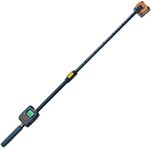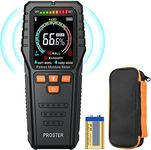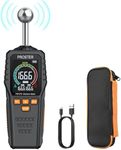Buying Guide for the Best Moisture Meter For Walls
Choosing the right moisture meter for walls is crucial for ensuring the structural integrity and safety of your home or building. Moisture meters help detect the presence of moisture in walls, which can indicate potential issues such as mold growth, water damage, or compromised insulation. When selecting a moisture meter, it's important to consider various specifications to ensure you get a device that meets your needs effectively.Type of Moisture MeterMoisture meters come in two main types: pin-type and pinless. Pin-type meters use electrodes that penetrate the wall to measure moisture levels, providing accurate readings for specific spots. Pinless meters use sensors to scan the surface, offering a non-invasive way to detect moisture over a larger area. If you need precise measurements in specific locations, a pin-type meter is ideal. For a quick scan of larger areas without causing damage, a pinless meter is more suitable.
Measurement RangeThe measurement range indicates the levels of moisture the meter can detect, usually expressed as a percentage. This is important because different materials have varying moisture content thresholds. For walls, a range of 5% to 40% is typically sufficient. If you're dealing with materials that can hold more moisture, such as wood, you might need a meter with a higher range. Choose a meter with a range that matches the materials you are testing to ensure accurate readings.
AccuracyAccuracy refers to how close the meter's readings are to the actual moisture content. High accuracy is crucial for identifying potential issues early and making informed decisions. Accuracy is often expressed as a percentage error. For general use, an accuracy within ±1% to ±3% is acceptable. If you require precise measurements for professional purposes, look for meters with higher accuracy. Consider your need for precision when selecting a meter.
Depth of MeasurementDepth of measurement indicates how deep the meter can detect moisture within the wall. This is important for identifying moisture that may not be visible on the surface. Depth can range from a few millimeters to several centimeters. For detecting surface moisture, a shallow depth is sufficient. For deeper issues, such as moisture trapped behind insulation or within the wall structure, a meter with greater depth capability is necessary. Choose based on the potential depth of moisture issues in your walls.
Display and ReadabilityThe display and readability of the moisture meter are important for ease of use. Look for meters with clear, easy-to-read digital displays that show moisture levels in percentage or other units. Some meters also offer backlit displays for use in low-light conditions. If you need to take readings in various environments, ensure the display is visible and understandable. Consider how often and where you will be using the meter to determine the importance of display features.
Additional FeaturesAdditional features can enhance the functionality of a moisture meter. These may include data logging, Bluetooth connectivity, and different measurement modes for various materials. Data logging allows you to track moisture levels over time, which is useful for monitoring ongoing issues. Bluetooth connectivity can enable easy transfer of data to other devices for analysis. Consider what extra features might be beneficial for your specific needs and choose a meter that offers those capabilities.














